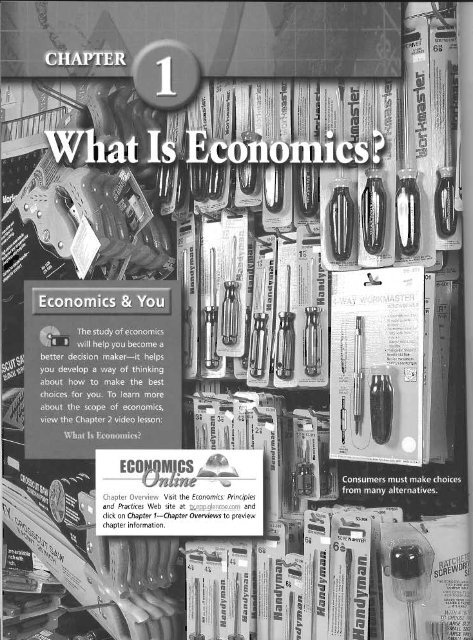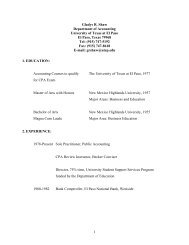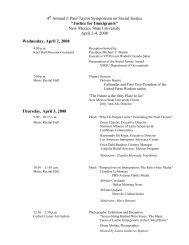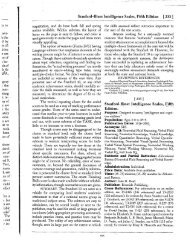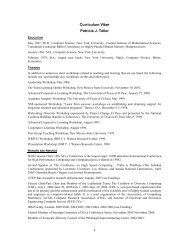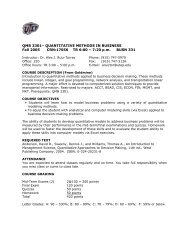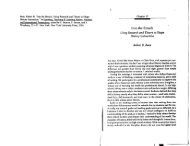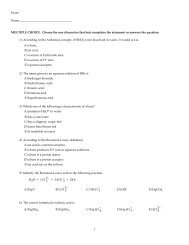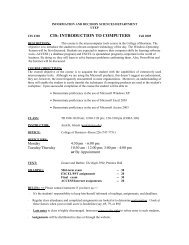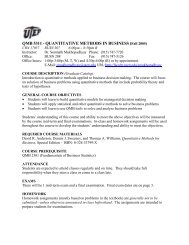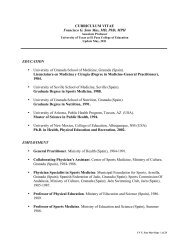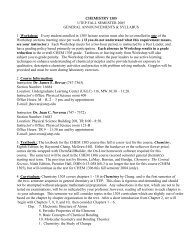Supply & Demand - Faculty.utep.edu
Supply & Demand - Faculty.utep.edu
Supply & Demand - Faculty.utep.edu
You also want an ePaper? Increase the reach of your titles
YUMPU automatically turns print PDFs into web optimized ePapers that Google loves.
Study GuideScarcit and the Science•cono ICSMain IdeaScarcity forces us to make choices. We can't haveeverything we want, so we are forced to choosewhat we want most.Reading StrategyGraphic Organizer As you read the section, completea graphic organizer like the one below by listingand describing the three economic choices everysociety must make.Economic choicesKey Termsscarcity, economics, need, want, factors of production,land, capital, financial capital, labor, entrepreneur,production, Gross Domestic Product (GOP)ObjectivesAfter studying this section, you will be able to:1. Explain the fundamental economic problem.2. Examine the three basic economic questions everysociety must decide.Applying Economic ConceptsScarcity Read to find out why scarcity is the basiceconomic problem that faces everyone.cHarris Poll Shows High Interestin EconomicsThe focus ou economics e~luca-lion is growing.American adultshave an exceptionallykeen in terest. in economics. More thanseven in ten say theyshare the same highleyel of interest ineconomics as they dopolitics, business a~dHnance. A full 96%believe basic economitsshould be taught inhigh sch001 Yet, half \. h - h 1" h . e ''Ldults and two out of three mg sc 00of t ese sam, . b' wmicstudent.s flunked an elementmy quiz on [ast ~co: eeotClearly the time has come to_ paccon~cPliSte'J'acy hi.,.her on the national <strong>edu</strong>cation agenda.noml . ) bTl "··'ti·on'll C()lJnci~,127, 1$)99 press reIease. etC "" • '.-Apron EconomiC Educationo you think. the study of economics is worthyour time and effort? According to the Harrispoll in the cover story, a huge percentage ofAmericans think it is. They must know what economistsknow-that a basic understanding of economicscan help make sense of the world around us.e Fundamenta Ec· nami ProblemHave you ever noticed that very few peopleare satisfied with the things they have?Someone without a home may want a small one;someone else with a small home may want a largerone; someone with a large home may want a mansion.Others want things like expensive sports cars,lavish jewelry, and exotic trips. Whether they are richor poor, most people seem to want more than theyalready have. In fact, if each of us were to make a listof all the things we want, it would include morethings than we could ever hope to obtain.The fundamental economic problem facing allsocieties is that of scarcity. Scarcity is the conditionthat results from society not having enough resourcesto produce all the things people would like to have.CHAPTER 1: WHAT IS ECONOMICS? 5
ScarcityUnlimited Limite~es /Wants Resour/ChoicesHowto ProduceII'I'L ere Is No Such Thing as a Free Lunc LIIBecause resources are limited, virtually everythingwe do has a cost-even when it seems as ifweare getting something "for free."For example, you may think you are getting afree lunch when you use a "buy one, get one free"coupon. However, while you may not pay for theextra lunch then and there, someone had to pay thefarmer for raising the food, the truck driver fordelivering the food, the chef for preparing thefood, and the server for serving the food.How does business recover these costs? Chance"are that the price of the giveaway is usually hiddensomewhere in the prices the firm charges for itsproducts. As a result, the more a business givesaway "free," the more it has to raise the prices forthe items it sells. In the end, someone always paysfor the supposedly "free" lunch-and that someonemay be you!Unfortunately, most things in life are not freebecause someone has to pay for the production inthe first place. Economic <strong>edu</strong>cators use the termTINSTAAFL to describe this concept. In short,this term means that There Is No Such Thing As AFree Lunch.As shown in Figur~ 1.1, scarcity affects almostevery decision we make. This is where the study ofeconomics comes in. Economics is the study ofhow people try to satisfy what appears to be seeminglyunlimited and competing wants through thecareful use of relatively scarce resources.Needs and WantsEconomists often talk about people's needs andwants. A need is a basic requirement for survivaland includes food, clolhing, and shelter. A want isa way of expressing a need. Food, for example, is abasic need related to survival. To satisfy the needfor food, a person may "want" a pizza or otherfavorite meal. Because any number of foods willsatisfy the need for nourishment, the range ofthings represented by the term want is muchbroader than that represented by the term need.ree B'asic QuestionsBecause we live in a world ofrelatively scarce1.resources, we have to make wise economicchoices. Figure 1.1 presents three of the basic questionswe have to answer. In so doing, we make decisionsabout the ways our limited resources will beused.WHAT to ProduceThe first question is that of WHAT to produce.Should a society direct most of its resources to theproduction of military equipment or to otheritems such as food, clothing, or housing? Supposethe decision is to produce housing. Should its limitedresources be used for low-income, middleincome,or upper-income housing? How many ofeach will be needed? A society cannot have everythingits people want, so it must decide WHAT toproduce.6 UNIT 1 FUNDAMENTAL ECONOMIC CONCEPTS
HOW to ProduceA second question is that of HOW to produce.Should factory owners use mass production methodsthat require a lot of equipment and few workers,or should they use less equipment and moreworkers? If an area has many unemployed people,the second method might be better. On the otherhand, mass production methods in countries wheremachinery and equipment are widely available canoften lower production costs. Lower costs makemanufactured items less expensive and, therefore,available to more people.,FOR WHOM to ProduceThe third question deals with FOR WHOM toproduce. After a society decides WHAT and HOWto produce, the things produced must be allocatedto someone. If the society decides to produce housing,should it be distributed to workers, professionalpeople, or government employees? If thereare not enough houses for everyone, a choice mustbe made as to who will receive the existing supply.These questions concerningWHAT, HOW; and FOR WHOMto produce are not easy for any societyto answer. Nevertheless, theymust be answered as long as thereare not enough resources to satisfYpeople's seemingly unlimited wants.not created by humans. "Land" includes deserts,fertile ftelds, forests, mineral deposits, livestock,sunshine, and the climate necessary to grow crops.Because only so many natural resources are availableat any given time, economists tend to think ofland as being fixed, or in limited supply.For example, there is not enough good farmlandto adequately feed all of the earth's population,nor enough sandy beaches for everyone toenjoy, nor enough oil and minerals to meet ourexpanding energy needs indefinitely. Because thesupply of a productive factor like land is relativelyfixed, the problem of scarcity is likely to becomeworse as population grows in the future.CapitalAnother factor of production is capital-thetools, equipment, machinery, and factories used inthe production of goods and services. Such itemsare also called capital goods to distinguish themfrom financial capital, the money used to buy thetools and equipment used in production.The Factors of ProdudionThe reason people cannot satisfYall their wants and needs isthe scarcity of productive resources.The factors of production, orresources required to produce thethings we would like to have, areland, capital, labor, and entrepreneurs.As shown in Figure 1.2, allfour are required if goods and servlcesare to be produced.LandIn economics, land refers to the"gifts ofnature," or natural resourcesaki 9 Dec"s 0 5 If we cannot have everything we want,then we have to choose what we want the most. Why must asociety face the choices about what, how, and for whom toproduce?CHAPTER 1: WHAT [S ECONOMICS' 7
The Factors of Production,J; ~Land,~~.c
y teachers, administrators, and other employees.Land, such as the iron ore, granite, and timber usedto make the building and desks, as well as the landwhere the school is located, is also needed. Finally,entrepreneurs are needed to organize the other threefactors and make sure that everything gets done.T eScope of con,omicsEconomics is the study of human efforts tosatisfy what appear to be unlimited andcompeting wants through the careful use of relativelyscarce resources. As such, it is a social sciencebecause it deals with the behavior of people asthey deal with this basic issue. There are four keyelements to this study: description, analysis, explanation,and prediction.Des ~p ioEconomics deals with the description of economicactivity. For example, you will often hearabout the Gross Domestic Product (GDP)-thedollar value of all final goods and services, andstructures produced within a country's borders in a12-month period. GDP is the most comprehensivemeasure of a country's total output and is a keymeasure of the nation's economic health.Economics is also concerned with what is producedand who gets how much, as well as with topicssuch as unemployment, inflation, internationaltrade, the interaction of business and labor, and theeffects of government spending and taxes.Description is important because we need toknow what the world around us looks like.However, description is only part of the picturebecause it leaves many important "why" and "how"questions unanswered.AnalysisIn order to answer such questions, economicsmust focus on the analysis of economic activity aswell. Why, for example, are prices of some itemshigh while others are low? Why do some peopleearn higher incomes than others? How do taxesaHect people's desire to work and save?UNITED STATES LEIN ENTREPRENEURSA vast majority of the owners of the nearly 20million businesses in the United States are entrepreneurs.Most either work for themselves orhave a few employees.A 10-nation study found that the United Statesleads when it comes to entrepreneurs. According tothe survey, nearly 1 in 12 Americans is trying to starta new business. In second place is Canada. The studyalso shows a strong link between business start-uprates and overall economic growth. The graphshows the percentage of the adult population startingnew busi nesses.ItalyBritain $SGermany1=::::;;;;:;~4'"DenmarkFrance,FinlandU.S.CanadaSource: 1999 Global Entrepreneurship Monitor-Critical Thinking1. AnaJyzlng Information In which nation isentrepreneurial activity strongest? Weakest?2. ki 9 Co p riso s How does the levelof North America's entrepreneurial activitycompare with Europe's?3. Dra ing Conclusions Do you think there isa link between business start-up rates andoverall economic growth? Why or why not?CHAPTER 1: WHAT IS ECONOMICS? 9
Capital"Capital" comprises the tools, equipment, andfactories used to produce goods and services.As the economy changes, some economists areadjusting the definition to include "tools" suchas knowledge and intellectual property. Anexample of such knowledge and intellectualproperty are databases and software.The importance of analysis is that it helps us todiscover why things work and how things happen.This, in turn, will help us deal with problems thatwe would like to solve.ExplanationEconomics is also concerned with the explanationof economic activity. After economists understandwhy and how things work, it is useful andeven necessary to communicate this knowledge toothers. If we all have a common understanding ofthe way our economy works, some economic problemswill be much easier to address or even fIX inthe future. When it comes to the GDP, you willsoon discover that economists spend much of theirtime explaining why the measure is, or is not, performingin the manner expected.PredictionFinally, economics is concerned with prediction.For example, we may want to know if people'sincomes are going to rise or fall in the future,affecting their spending habits in the marketplace.Or, perhaps a community trying to choose betweenhigher taxes on homeowners or higher taxes onbusinesses needs to know the consequences of eachalternative before it makes its choice.The study of economics can help to make thebest decision in both situations. Because economicsdeals with the study of what is, or what tends tobe, it can help predict what may happen in thefuture, as well as the likely consequences of differentcourses of action.Finally, it is also important to realize that theactual decisions about the economic choices to bemade are the responsibility of all citizens in a freeand democratic society. Therefore, the study ofeconomics helps all of us to become moreinformed citizens and better decision makers.Checking for Understanding1. Main Idea Using your notes from the graphicorganizer activity on page S, explain why asociety must face the choices about WHAT,HOW, and FOR WHOM to produce.2. Key Terms Define scarcity, economics, need,want, factors of production, land, capital,financial capital, labor, entrepreneur, production,Gross Domestic Product (GOP).3. Describe the fundamental economic problem.4. List the three basic economic questions everysociety must answer.5. Describe the factors of production.6. List the four key elements of economics.Applying Economic Concepts7. Scarcity How does sea rcity affect you r life?Provide several examples of items you had todo without because of limited resources.Explain how you adjusted to this situation.For example, were you able to substituteother items for those you could not have?~JriticalTI&'inldn8. Synthesizing Information Give an exampleof a supposedly "free" item that you seeevery day. Explain why the item is not reallyfree by stating who or what actually paysfor it.® Practice and assess key social studies skills withthe Glencoe Skillbuilder lnteractive Workbook,Level 2.10 UNIT 1 FUNDAMENTAL ECONOMIC CONCEPTS
A/ex; de Tocqueville a French traveler,wrote about his travels in the UnitedStates during th 1830s. His book,Democracy in America, a two~volumestudy of the American people and theirinstitutions, is stiIJ relevant today.The Role ollheEntrepreneurWhat astonishes me in the United States isnot so mucb the marvelous grandeur of suchundertakings as the innumerable multitudeof small ones.-Alexis de Tocqueville, 1835What [de Tocqueville noticed nearly 160years ago] -before the advent of AppleComputer, Genentech, Microsoft, or Nucor-isjust as true today. The only difference is that thespirit of enterprise is more than ever a globalphenomenon with few bounds.From the row of kiosks selling goods on nearlyevery block in Moscow to the cramped factories inTaiwan, Russian biznez-me-n and Chinese dJangshangare reshaping their nations' economies inmuch the same way asthose ingenious oldYankees created the basisfor America's business culturesjust after independencewas won.Any [de Tocqueville ofmodern -times] wouldnotice something elseabout this global shift:e-ws cChanges in the rules of thebusiness game are puttinga premium on theentrepreneurial qualitiesof [the smaller]companies. Today'ssuccessful enterprisesare nimble, innovative,close to the customer,and quick to themarket. They're notbureaucratic, centrally controlledinstitutions that are slowto change. It adds us to a new managementcatechism with many of the hallmarks ofsmall business....Sure, some industries, such as auto making andpetrochemicals, still require size and scale. But theswift pace of technological change and the fragmentationof markets aTe eroding the traditionaleconomies of scale. Indeed, some managementthinkers now speak of the "diseconomies ofscale," the unresponsiveness, sluggishness, andhigh costs that come with bureaucracy. While thebehemoths try to adjust to new competitive realities,younger and smaller companies haveemerged as the agents of change in economiesaround the world....-Reprinted &001 Small Business Trends and Entreprenet
SillIly GuideSECT)Basic Economic ConceptsAn economic product is a good or service that is useful,relatively scarce, and exchangeable.Reading StrategyGraphic Organizer As you read the section, describethree different transactions that could take place inthe factor market. Use a web like the one below tohelp you organize your answer.Factor markettE~evKey'hnnseconomic product, good, consumer good, capitalgood, service, value, paradox of value, utility, wealth,market, factor market, product market, economicgrowth, productivity, division of labor, specialization,human capital, economic interdependenceObjectivesAfter studying this section, you will be able to:1. Explain the relationship among scarcity, value,utility, and wealth.2. Understand the circular flow of economic activity.Applying Economic ConceptsSpecialization Read to discover how specializationincreases production.IjOn SpecializationTo take an example, ... One man draws au t thewire, another straightens it, a third cuts it, a fourthpoints it, a fifth grinds it atthe top for receiving thehead; to make the headrequires two or threedistinct operations;to put it on, is apeculiar business, towhiten the pins isanother; it is even atrade by itself to putthem into the paper;and lthe making on apin is, in this manner,divided into about eighteen distinct operations.12-Adam 5rtllth. The Wealth ofl'lat;OJl., 1776Adam Smithconomics, like any other social science, hasits own vocabulary. To understand economics,a review of some key terms is necessary.Fortunately, most economic terms are widely used,and many will already be familiar to you.oods, Services, and ConsumersIEconomics is concerned with economicproducts-goods and services that are useful,relatively scarce, and transferable to others.Economic products are scarce in an economicsense. That is, one cannot get enough to satisryindividual wants and needs. Because of these characteristics,economic products command a price.GoodsThe first type of economic product is a goodanitem that is economically useful or satisfiesan economic want, such as a book, car, or compactdisc player. A consumer good is intendedfor final use by individuals. When manufacturedgoods are used to produce other goods and services,they are called capital goods. An example
of a capital good would be a robot welder in a factory,an oven in a bakery, or a computer in a highschool.Any good that lasts three years or more whenused on a regular basis is called a durable good.Durable goods include both capital goods, such asrobot welders, and consumer goods such as automobiles.A nondurable good is an item that lastsfor less than three years when used on a regularbasis. Examples of nondurable goods include food,writing paper, and most clothing items.ServicesThe other type of economic product is a service,or work that is performed for someone. Servicesinclude haircuts, home repairs, and forms of entertainmentsuch as concerts. They also include thework that doctors, lawyers, and teachers perform.The difference between a good and a service is thata service is intangible, or something that cannot betouched.ConsumersThe consumer is a person who uses goods andservices to satisfy wants and needs. As consumers,people indulge in consumption, the process ofusing up goods and services in order to satisfywants and needs.Economists knew that scarcity is required forvalue. For example, water was so plentiful in manyareas that it had little or no value. On the otherhand, diamonds were so scarce that they had greatvalue. The problem was that scarcity by itself is notenough to create value.UtilityIt turned out that for something to have value, itmust also have utility, or the capacity to be usefuland provide satisfaction. Utility is not somethingthat is fixed or measurable, like weight or height.Instead, the utility of a good or service may varyfrom one person to the next. One person may geta great deal of satisfaction from a home computer;another may get very little. One person may enjoya rock concert; another may not. A good or servicedoes not have to have utility for everyone, onlyutility for some.For something to have value, economistsdecided, it must be scarce and have utility. This isthe solution to the paradox ofvalue. Diamonds arescarce and have utility-and therefore they possessa value that can be stated in monetary terms. Waterhas utility, but is not scarce enough in most placesto give it much value. Therefore, water is lessexpensive, or has less value, than diamonds.Valu , Utility, .ndathIn economics, value refers to a worth thatcan be expressed in dollars and cents. Why,however, does something have value, and why aresome things worth more than others? To answerthese questions, it helps to review an early problemfaced by economists.Paradox of ValueAt first, early economists were puzzled by a contradictionbetween necessities and value called theparado:x ofvalue. The paradox of value is the situationwhere some necessities, such as water, have littlemonetary value, whereas some non-necessities, suchas diamonds, have a much higher value.Durable Goods Orders The Department of Commerce'sreport on durable goods orders highlightsthe number of new orders placed witlh domesticmanufacturers for goods intended to last overthree years. The report is divided into broad categories;these include defense, nondefense, andcapital and noncapital goods, Noncapital goodsare generally of the consumer spending varietyand 'Include automobiles and large appliances.Capital goods tend to be of the investment spendingnature, while defense goods indicate governmentspending.- - - - -----~-CHAPTER 1: WHAT IS ECONOMICS' 13
WealAnother concept is wealth. Wealth, in an economicsense, is the accumulation of those productsthat are tangible, scarce, useful, and transferable fromone person to another. Consequently, a nation'swealth is comprised of all items, including naturalresources, factories, stores, houses, motels, theaters,furniture, clothing, books, highways, video games,and even footballs.While goods are counted as wealth, services arenot because they are intangible. However, this doesnot mean that services are not useful. Indeed, whenAdam Smith wrote The Wealth ofNations in 1776, hewas referring specifically to the ability and skills ofa nation's people as the source of its wealth. Toillustrate, if a country's material possessions weretaken away, its people, through their skilled efforts,could restore these possessions. On the other hand,if a country's people were taken away, its wealthwould deteriorate.e Circular '0Activity0' EconoThe wealth that an economy generates ismade possible by the circular flow of economicactivity. The key feature of this circular flowis the market, a location or other mechanism thatallows buyers and sellers to exchange a certain economicproduct. Markets may be local, regional,national, or global. More recently, markets haveevolved in cyberspace, with buyers and sellers interactingthrough computer networks without leavingthe comfort of their homes.ador MarketsHow does this circular flow operate? As shownin Fjgure 1.3. individuals earn their incomes infactor markets, the markets where productiveresources are bought and sold. This is where entrepreneurshire labor for wages and salaries, acquireland in return for rent, and borrow money forinterest. The concept of a factor market is a simplifiedversion of the real world, of course, but itis nevertheless realistic. To illustrate, you participatein the factor market whenever you go to workand sell your labor to an employer.• IeNatural Resources Fertile land is a naturalresource and an item of wealth. Why are naturalresources considered part of the nation'swealth?arKetsAfter individuals receive their income from theresources they sell, they spend it in produd markets,markets where producers sell their goods and servicesto consumers. Thus, the money that individualsreceive from businesses in the factor marketsreturns to businesses in the product markets.Businesses then use this money to produce moregoods and services-and the cycle, through economicactivity, repeats itselfAs you can see from Figure 1.3, markets serve asthe main links between individuals and businesses.Note that money circulates on the outside, illustratingpayments for goods, services, and the factorsof production. The actual factors ofproduction, and the products made with these productiveinputs, flow in the opposite direction onthe inside.14 UNIT 1 FUNDAMENTAL ECONOMIC CONCEPTS
P0 uct vity .dE,conomic Gro h oducfv'tyf.conomic growth occurs when a nation'sEveryone benefits when scarce resources aretotal output of goods and services increasesused efficiently. This is described by the termover time. This means that the circular flow in productivity, which is a measure of the amount ofoutput produced by a given amount of inputs in aiglL~ 1.3 becomes larger, with more factors ofprospecificperiod of time. Productivity goes up whenductlOn,goods, and services flowing in one direcevermore output can be produced with the sametion, and more payments flowing in the oppositedirection. A number of factors are responsible foramount of inputs in the same amount of time. Foreconomic growth, but productivity is the most example, if a company produced 500 units of almportant.product in one period, and if it produced 510 inThe Circular Flow of Economic ActivityProductMarketsBusinessIncomeGoodsServicesGood5ervkesBusinessesLandCapitallaborEntreprene urSFactorMarketsCHAPTER 1 WHAT IS ECONOMICS? 15
the next period with the same number of inputs,then productivity went up.Productivity is often discussed in terms of labor,but it applies to all factors of production. For thisreason, business owners try to buy the most effIcientcapital goods, and farmers try to use the mostfertile land for their crops.Division of Labor and SpecializationDivision of labor and specialization can improveproductivity. Division 'of labor takes place whenwork is arranged so that individual workers do fewertasks than before. In most cases, a worker who performsa few tasks many times every day is likely tobecome more profICient than a worker who performshundreds of different tasks in the same period.IIEffect of Education on Incomeess Than 9th Grade9th to 12th Grade (no diploma)High School Graduate & EquivalencySome College, no degreeAssociate DegreeBachelor's DegreeMaster's DegreeProfessional DegreeDoctorate Deg ree~.Specialization takes place when factors of productionperform tasks that they can do relativelymore efficiently than others. Note that specializationis not limited to a single factor of productionsuch as labor. For example, complex industrialrobots are often built to perform just one or twosimple assembly line tasks. In regional specialization,different regions of the country often specializein the things they can produce best-as whenIdaho specializes in potatoes, Iowa in corn, andTexas in oil, cotton, and cattle.One of the best examples of the advantagesoffered by the division of labor and specialization isHenry Ford's introduction of the assembly line intoautomobile manufacturing. This process cut the timenecessary to assemble a car from a day and a half tojust over 90 minutes. It also cut the price ofa new carby more than 50 percent. The resultwas an improvement in productivity.Another example of the changesthat can result from specialized toolscan be seen in American agriculture.In 1910 it took more than 13 millionfarmers to feed the U.S. population,at that time about 90 million. Today,2 million farmers can feed a populationthat is more than three times aslarge as it was in 1910.lllw$23,139 $16,636$27,067 $19,620$36,805 $24,228$44,558 $30,157$45,876 $31,855$63,491 $41,106$75,527 $49,844$130,711 $72,188$108,334 $69,085SQurce: u.s. Department of Commerce, Bureau of the Census, 2001Visit tlr.!'Dp@coo.cQfl1 and click onTextbook Updates-Chapter 1 foran update of the data.lnvesti in man CaDitalOne of the main contributions toproductivity comes from investmentsin human capital, the sum of theskills, abilities, health, and motivationof people. Government can invest inhuman capital by helping to provide<strong>edu</strong>cation and health care. Businessescan invest in training and other programsthat improve the skill andmotivation of its workers. Individualscan invest in their own <strong>edu</strong>cation bycompleting high school, going totechnical school, or going to college.Figure J.4 shows that investmentsin <strong>edu</strong>cation can have substantialpayoffs. According to the data in thetable, high school graduates havesubstantially higher incomes than16 UNIT J FUNDAMENTAL ECONOMIC CONCEPTS
l1ongraduates, and college graduates make evenmore than high school graduates. Educationalinvestments require that we make a sacrifice today sowe can have a better life in the future-and fewinvestments generate higher returns.Investing in the FutureBusinesses, government, and other organizationsface many of the same choices that individualsdo. Investments in human capital and physicalcapital can eventually increase production and promoteeconomic growth. Faster economic growth,in turn, increases the amount ofgoods and servicesavailable to us.Economic IinterdependenceThe American economy has a remarkable degreeofeconomic interdependence. This means that werely on others, and others rely on us, to provide thegoods and services that we consume.Events in one part of the country or the worldoften have a dramatic impact elsewhere. To illustrate,a labor dispute between several hundred professionalbasketball players and a handful of owners can affectFirst and Biggest The world's first programmablecomputer, the Electronic Numerical Integrator andComputer (ENIAC), was developed in 1946. Standingalmost 10 feet tall and 80 feet wide, ENIAC couldperform up to 5,000 operations per second. Personalcomputers today easily outperform ENIAC.the lives of tens of thousands of people who parkcars, sell tickets, serve food at the games, and sellNBA apparel and memorabilia all across the country.Or, bad weather in countries where sugar cane isgrown can affect sugar prices in the United States,which in turn can affect the price of snack foods andthe demand for sugar substitutes elsewhere.This does not mean that economic interdependenceis necessarily bad. The gain in productivityand income as a result of increased specializationalmost always offsets the costs associated with theloss in self-sufficiency. However, we need to understandhow all the parts fit together, which is onereason why we study economics.Checking for Understanding1. Main Idea Using your notes from the graphicorganizer activity on page 12, explain thedifferent transactions that take place in theproduct market.2. Key Terms Define economic product, good,consumer good, capital good, service, value,paradox of value, utility, wealth, market,factor market, product market, economicgrowth, productivity, division of labor,specialization, human capital, economicinterdependence.3. Discuss the relationship among scarcity, value,utility, and wealth.4. Describe the circular flow of economic activity.5. Explain why productivity is important to economicgrowth.Applying Economic Concepts6. Specialization Provide at least three exampleseach of specialized workers and capital thatare used in your school to prOVide the serviceof <strong>edu</strong>cation. Would productiVity go up ordown if these specialized capital goods andworkers were not available to your school?Explain why or why not.7. Making Comparisons What is the differencebetween a durable good and a nondurablegood)8. Drawing Conclusions In what way do businessesand households both supply anddemand in the circular flow model?Practice and assess key sodal studies skills withthe Glencoe Skillbuilder Interactive Workbook,Level 2.CHAPTER L WHAT IS ECONOMICS' 17
TIlt Father of CL.lssical.....conOlnlCS:Adam nith(l7~3-17~!})Take a look at a Scottish pennyand you'll be surprised by whatyou see. The person pictured wasnot a political or military fLgure,but an economist: Adam Smith.It is a fItting tribute to a man whocontributed so much to economics.HJS LIfESmith was born in Kirkcaldy,Scotland. After graduating fromGlasgow University, he traveledto England and enrolled at OxfordUniversity. Six years later, Smithreturned to Scotland to lectureat Edinburgh University and athis alma mater, where he wasimmensely popular with his students.Smith became a tutor to ayoung duke, and traveled throughoutEurope.HIS IDEASSmith met and exchanged ideaswith French writer Voltaire,Benjamin Franklin, and the Frencheconomist Qlesnay. His travelshelped him formulate the ideas putforth in Tbe Wealth qfNations (1776).In Tbe Wealth ofNations, Smithobserved that labor becomes moreproductive as each worker becomesmore skilled at a single job. He saidthat new machinery and the divisionof labor and specializationwould lead to an increase in productionand greater "wealth of nations."Smith also put forth what was thena radical new idea: that the wealthof a nation should be defined as thesum of its labor-produced goods,not by who owned those goods.Smith's most influential contribution,however, concerned competitionin the marketplace. Everyindividual, Smith wrote, "intendsonly his own gain, and he is in this... led by an invisible hand....By pursuing his own interest he frequentlypromotes that of the society...."Smith argued that a freemarket isn't chaotic, but that competitionacts as an "invisible hand"that guides resources to their mostproductive uses. A truly free,competitive market-operating witha minimum of government intervention-wouldbring about thegreatest good for society as a whole.The English aristocracy ridiculedThe Wealth ofNations. Business people,however, were delighted tohave a moral justifIcation for theirgrowing wealth and power. Soon,Smith's doctrine of laissez/aire(French, "let it be"), meaning minimalgovernment intervention ineconomic affairs, became the economicwatchword in Europe, and istoday the economic watchword ofmuch of the world.Examining the Profile1. Summarizing Ideas SummarizeSmith's contribution to economicthought.2. Synthesizing Information Explainhow Smith's Ideas are eVident in theworkings of the American economy. l18 UNIT 1 FUNDAMENTAL ECONOMIC CONCEPTS
o oe • •5 onsStu.dy Guideaia IdeaTrade-offs are present whenever choices are made,Reading StrategyGraphic Organizer As you read this section, completea graphic organizer similar to the one below byexplaining what you need to know to become agood decision maker,Making decisionsKey Termstrade-off, opportunity cost, production possibilitiesfrontier, cost-benefit analysis, free enterprise economy, standard of livingo je "esAfter studying this section, you will be able to:1. Analyze trade-offs and opportunity costs.2. Explain decision-making strategies,A lyin Econ mit on eptsOpportunity Costs Read to find out how your decisions are measured in terms of opportunity costs,over Stor~ ------Cost Benefit AnalysisResearch haslong demonstratedthe <strong>edu</strong>cational valueof earlv interventionfo~ Ameri.ca'sat.risk dUldren, buta new study alsoshows the federalprograms are a wisepublic investment,[AJ cost-benefit'malvsis of the fed~rally funded Chi Social programs involve trade-offscago Child-Parent and oppOltunit)' costs,Center program,which serves chil- , ,. . ,'tv-'ncome families i.n Chlcagos lime) CI,dren from 1ow I . f $6 730 ertl . t] an average :ll1nual cost a , Pr1 SlOWS 1a . , tv t large',h'ld generated a total return to sone, a cC 1 ...of $47,759 per participant.. AScribe Newswi,re. June 26. 2OOJ.he process of making a choice is not alwayseasy. Still, individuals, businesses, and governmentagencies, like the Chicago ChildParent Center program, who try to satisfy people'swants and needs, must make decisions. Becauseresources are scarce, consumers need to make wisechoices. To become a good decision maker, youneed to know how to identify the problem andthen analyze your alternatives. Finally, you have tomake your choice in a way that carefully considersthe costs and benefits of each possibility.Tra e- ffs andpportunity CostrjU There are alternatives and costs to every.. thing we do. In a world where "there is nosuch thing as a free lunch," it pays to examine theseconcepts closely.Trade-OffsThe first thing we must recognize is that peopleface trade-offs, or alternative choices, wheneverthey make an economic decision. To helpmake the decision, constructing a grid such asthat in Figure 1.5 shows one way to approach theCHAPTER 1 WHAT IS ECONOMICS? 19
--_.~Opportunity Costproblem. This grid summarizes a decision to bemade by Jesse, a newspaper carrier, whose dilemma ishow to spend a gift of $50 in the best way possible.Jesse realizes that several alternatives are appealing-a soccer ball, jeans, a portable CD player, several CDs, or concert tickets. At the same time, herealizes that each item has advantages and disadvantages. Some of these items are more durablethan others, and some might require his parents'consent. Some even have additional costs whileothers do not-the CD player would require batteries and the concert tickets would require the use ofhis parents' car.To help with his decision, Jesse draws a grid thatlists his alternatives and several criteria by which tojudge them. Then he evaluates each alternativewith a "yes" or "no." In the end, Jesse chooses thejeans because they satisfy more of his criteria thanany other alternative.Using a decision-making grid is one way to analyze an economic problem. Among other things, itforces you to consider a number of relevant alternatives. For another, it requires you to identify thecriteria used to evaluate the alternatives. Finally, itforces you to evaluate each alternative based on thecriteria you selected.People often think of cost in terms of dollarsand cents. To an economist, however, cost oftenmeans more than the price tag placed on a goodor service. Instead, economists think broadly interms of opportunity cost-the cost of the nextbest alternative use of money, time, or resourceswhen one choice is made rather than another.When Jesse made his choice and decided to purchase the jeans, his opportunity cost was the nextbest choice-the soccer ball or the CD player-thathe gave up.Suppose you spend $5,000 on a used car. Theopportunity cost of the purchase is the value of thestereo, apartment, vacation, or other items andactivities that you could have purchased with themoney spent on the car.Even time has an opportunity cost, althoughyou cannot always put a monetary value on it. Theopportunity cost of taking an economics class, forexample, is the history or math class that you couldnot take at the same time. Thus, part of makingeconomic decisions involves recognizing and evaluating the cost of the alternatives as well as makingchoices from among the alternatives.Alternatives'--Costs $5() r Dur.able?'iwillJesse's Decision-Making GridCriteriaparents I Future expense [ Can useI ~__-+- or less? __ . ----'_L- approve? I unnecessary? I anytime?\1Several CDs __y~_"IConcert ~_icke~syes ~yes __' yes _. noyes no. I _ ~__~-n~CD player. yes =1 yes r 1.-- uP"J--r-nn -- --- --- "I ISocce; ball =--\ yes _~. ;-;- I yes I yes no-Jeans -\ yes --r---- yes , yes -1' yes yesAdapted from A Framework for Teaching Basic EconomICs,Economics America National Council on Economic Education, 1996noyes.,~20 UNIT 1 FUNDAMENTAL ECONOMIC CONCEPTS
I-- -- --Econom ic Choices,../ R&AL-I:Z:~ Yoif~ AL.t...SV1~YI NG, BuT l-£I5 ffla:THe I?4CTSTrade-Offs In this cartoon, the king faces a trade-off between crops and catapults. What is the opportunitycost of obtaining two more catapults?Pad c·o Possibi tiesA popular model economists use to illusjtrate the concept of opportunity cost is theproduction possibilities frontier, a diagram representingvarious combinations of goods and/orservices an economy can produce when all productiveresources are fully employed. In the classicexample shown in Figure 1.6, a mythical countrycalled Alpha produces two goods-guns and butter.Identifying Possible AlternativesEven though Alpha only produces two goods,the country has a number of alternatives availableto it. For example, it could choose to use all of itsresources to produce 70 units ofguns and 300 unitsof butter, which is shown as point a in Panel A ofFigure 1.6. Or, it could shift some ofits resources outof gun production and into butter, thereby movingto point b. Alpha could even choose to produceat point c, which represents all butter and no guns,or at point e, which is inside the frontier.Alpha has many alternatives available to it,which is why the figure is called a production "possibilities"frontier. Eventually though, Alpha willhave to settle on a single combination such aspoint a, b, or any other point on or inside thecurve, because its resources are limited.Fully Employed ResourcesAll points on the curve such as a, b, and c representmaximum combinations of output possible ifall resources are fully employed. To illustrate, supposethat Alpha is producing at point a and thepeople would like to move to point d, which representsthe same amount of guns, but more butter.As long as all resources are fully employed atpoint a, however, there are no extra resources availableto produce the extra butter. Therefore, point dcannot be reached, nor can any other point outsidethe curve. This is why the figure is called a productionpossibilities "frontier"-to indicate the maximumcombinations of goods and/or services thatcan be produced.CHAPTER 1: WHAT IS ECONOMICS;; 21
Opportunity Costhomework and spending time with your friends. Ifyou decide to spend extra hours on your homework,the opportunity cost of this action is lesstime with your friends.?.;aking Choices The nation incurs opportunitycosts when it makes choices. The money spenton defense cannot at the same time be spent onhealth services; money spent on health servicescannot be spent on <strong>edu</strong>cation, and so on. Whydoes every choice involve an opportunity cost?Opportunity CostSuppose that Alpha was producing at point aand that it wanted to move to point b. This isclearly possible so long as point b is not outside thefrontier. As shown in Panel B of Figure 1.6, theopportunity cost of producing the 100 additionalunits of butter is the 30 units of guns given up.As you can see, opportunity cost is a generalconcept that is expressed in terms of trade-offs, orin terms of things given up to get something else.Opportunity cost is not always measured in termsof dollars and cents. For example, you need to balancethe time you spend studying and doingThe Cost of Idle ResourcesIf some resources were not fully employed, thenit would be impossible for Alpha to reach its potential.To illustrate, suppose that Alpha was producingat point b in Panel A of Figure 1.6 when workers inthe butter industry went on strike. Butter productionwould fall, causing total output to change to point e.The opportunity cost of the unemployed resourceswould be the 100 units of lost production.Production at e could also be the result of otheridle resources, such as factories or land that areavailable but are not being used. As long as someresources are idle, the country cannot produce onits frontier-which is another way of saying that itcannot reach its full production potential, althoughit can produce at some point inside it.Economic GrowthThe production possibilities frontier representspotential output at a given point in time.Eventually, however, population may grow, the capitalstock may grow, and productivity may increase.If this happens, then Alpha will be able to producemore in the future than it can today.The effect of economic growth is shown inPanel C ofFigme 1.6. Economic growth made possibleby having more resources or increased productivitycauses the production possibilitiesfrontier to move outward. Economic growth willeventually allow Alpha to produce at point d,which it could not do earlier.Student Web Activity Visit the Economics: Principlesand Practices Web site at :t&ePQ.glencoe.com and clickon Chapter 1-Student Web Activities to learn moreabout what economists do.22 UNIT 1 FUNDAMENTAL ECONOM1C CONCEPTS
hinking Like a EcoomistBecause economists study how people satjisfy seemingly unlimited and competingwants with the careful use of scarce resources, theyare also concerned with strategies that will help usmake the best choices. Some of these strategies arediscussed here; others will be discussed in laterchapters.The ProductionPossibilities Frontier" Alternative Possibilitiesd70 - • 0()uId Si· pie ModelsOne of the most important strategies of economistsis the economic model. A model is a simplifIedtheory or a simplified picture of whatsomething is like or how something works. Simplemodels can often be constructed that r<strong>edu</strong>ce complexsituations to their most basic elements. Toillustrate, the circular flow diagram in Figw'e 1.3 isan example ofhow complex economic activity canbe r<strong>edu</strong>ced to a simple model.Another basic model is the production possibilitiesffontier illustrated in Figure 1.6. Realistically,of course, economies are able to produce morethan two goods or services, but the concepts oftrade-offs and opportunity costs are easier to illustrateifonly two products are examined. As a resul t,simple models such as these are sometimes all thateconomists need to analyze or describe an actualsituation.It is important to remember that models arebased on assumptions, or things that we take forgranted as true. We use them as facts even thoughwe can't be sure that they are. For example, youmight assume that a restaurant is out of your pricerange. You might not even try it because youassume you cannot afford it. However, you mightbe wrong-the prices at the restaurant might bequite reasonable. The quality of a model is no betterthan the assumptions that it is based on.It is also important to keep in mind that modelscan be revised. Economists use models to betterunderstand the past or present and to predict thefuture. If an economic model results in a predictionthat turns out to be right, the model can beused again. If the prediction is wrong, the modelmight be changed to make better predictions thenext time.III~34070300 400ButterOpportunity CostThe opportunity costof producing 100 unitsof butter is the 30 gunsgiven up.ButterIncreased productivityand additional factorsof production expandproduction possibilities.Butter300 400ccCHAPTER 1: WHAT IS ECONOMICS) 23
Employ Cost-Benefit AnalysisMost economic decisions can be made by usingcost-benefit analysis, a way of thinking about aproblem that compares the costs of an action tothe benefits received. This is what Jesse did in thedecision-making matrix shown in Figure 1.5. Thisdecision can be made subjectively, as when Jesseselected the jeans. Or, the decision can be moreformal, especially if the costs of the various alternativesare different.To illustrate, suppose that you like choices A andB equally well. If B costs less, however, then itwould be the better choice because you would getmore satisfaction per dollar spent. Businesses makeinvestment decisions in exactly this manner, choosingto invest in projects which give the highestreturn per dollar spent. Cost-benefit studies, likethe one described in the cover story, can also beused to evaluate the effectiveness of many publicassistance programs.Economists study the way society distributesscarce resources to producegoods and services. They carryoninquiries, collect and analyze data,and observe economic trends.The WorkEconomists in the private sectoradvise businesses and other organizationson such topics as energycosts, inflation, imports, and employmentlevels. Those who work for variousgovernment agencies may studyeconomic conditions in the UnitedStates or in other countries to estimate the economiceffects of new legislation or pUblic policies.Qual ificationsGraduate training is required for most economists in theprivate sector. Individuals who wish to secure an entryleveljob in the federal government must have a bacheI'or's degree, with a focus on economics and on statistics,accounting, OJ calculus.Take Small, Incremental StepsFinally, and whenever possible, it also helps tomake decisions by taking small, incremental stepstoward the final goal. This is especially valuablewhenever we are unsure of the exact, or total, costinvolved. If the cost turns out to be larger than weanticipated, then the resulting decision can bereversed, without too much being lost.For example, if someone offers you a hot beverage,it might be best to take a small sip first. Thiswill allow you to find out if the beverage is coolenough to drink, without paying too high a priceif it is not. Few decisions are all-or-nothing decisions-sometimesit helps to do a little bit at atime.The Road AheadThe study of economics does more than.... explain how people deal with scarcity.Economics also includes the study of how thingsare made, bought, sold, and used. It helps answersuch questions as, Where do these products comefrom? Who makes them? How are they made?How do they get to the stores? Who buys them?It provides insight as to how incomes are earnedand spent, how jobs are created, and how theeconomy works on a daily basis. It also provides amore detailed understanding of a free enterpriseeconomy-one in which consumers and privatelyowned businesses, ratber than the government,make the majority ofthe WHAT, HOW, and FORWHOM decisions.TOpics and IssuesThe study of economics will provide a workingknowledge of property rights, competition, supplyand demand, the price system, and the economicincentives that make the American economy function.Along the way, topics such as unemployment,the business cycle, inflation, productivity, and economicgrowth will be covered. The role ofbusiness,labor, and government in the American economyalso will be examined, along with the relationshipof the United States economy to the internationalcommunity. All of these have a bearing on our24 UNIT 1 FUNDAMENTAL ECONOMIC CONCEPTS
s1andanl ofliving-the quality of life based on thepossession of the necessities and luxuries that makelife easier. You will learn how we measure the valueof our production and how productivity helpsdetermine our standard of living. You will find,however, that the way the American people makeeconomic decisions is not the only way to makethese decisions. Economists have identified threebasic kinds of economic systems. You will analyzethese systems in Chapter 2.Economi 10 Cifze 5 ~pThe study of economics helps us to become betterdecision makers-both in our personal lives andin the voting booths. Economic issues often aredebated during political campaigns, and we need tounderstand the issues before deciding which candidateto support. Most of today's political problemshave important economic aspects: How importantis it that we balance the federal budget? How can webest keep inflation in check? What methods can weuse to strengthen our economy? The study of economicswill not provide you with clear-cut answersto all questions, of course, but it will give you a betterunderstanding of the issues involved.Making the Rational ChoiceYou have already learned in this chapter thateconomists study how decisions are made. Everytime a choice is made something is given up.Rational choice is taking the things with greatervalue and giving up those with lesser value. That'sthe rational thing to do.But which things have greater value? If everyonefelt the same about what they did and did notwant, deciding how to use our resources would besimple; the problem is we don't all agree. Whenyou make a decision for yourself alone, it doesn'tmake much difference how others feel. But manyof your decisions will affect other people who maynot share your ideas. Making the best choices forgroups of people is hard to do.Textbook economics can be divided into neatsections for study, but the real world is not soorderly. Society is dynamic and things are alwayschanging. In addition, people have different degreesof ambition, strength, and luck. Opinions also differ,and some issues never seem to be settled.In practice, the world of economics is complexand the road ahead is bumpy. Studying and understandingeconomics, however, is vital to ourunderstanding of how the world around us works.ecking for U d~r and n_1. Main Idea Using your notes from the graphicorganizer activity on page 19, explain whatpeople try to achieve when they make decisionsor trade-ofts.2. Key Terms Define trade-ofts, opportunitycost, production possibilities frontier, costbenefitanalysis, free enterprise economy,standard of Iivi ng.J.Describe the relationship between trade-oftsand opportunity costs4. List the decision-making strategies that economistsuse.5. Explaio why the study of economics is importantto the American free enterprise system.Applying Econom" Concepts6. Opportunity Costs Identify several possibleuses of your time that will be available to youafter school today. What will you actually do,and what will be the opportunity cost of yourdecision? Explain how your decision will orwill not aftect your friends and members ofyour family.Cril·icang .......iiiillllliiiiiiiiiiiiiiiiiii~7. Making Generalizations Study the decisionmakinggrid on page 20 Explain the advantagesof using such a grid to evaluatealternatives.:--: _ Pramte and a55e5S key social studies skills with~ the Glencoe Skillbuilder Interactive Workbook,Levell.CHAPTER 1 WHAT [$ ECONOMICS? 25
1ar ty.a the Seien e fo omlcs (pages 5-10)• TIle basic economic problem of scarcity is due tothe combination of people's seemingly unlimitedwants and relatively scarce resources.• In a world of scarce resources, There Is No SuchThing As A Free Lunch (TINSTAAFL).• Because of scarcity, societyhas to decide WHAT, HOW,and FOR WHOM toproduce.• Land, capital, labor, andentrepreneurs are the fourfactors ofproductionrequired to produce the thingsthat people use.• Entrepreneurs are risk-taking individuals who go intobusiness in order to make a profit; they organize theother factors of production.• The scope of economics deals with description,analysis, explanation, and prediction.2Basic Economc one ts (pages 12-17)• Consumers use goods and services to satisfy theirwants and needs.• Something has value when it has utility and is relativelyscarce.• Wealth consists of products that are scarce, useful,and transferable to others, but wealth does notinclude services, which are intangible.Markets link individuals and businesses in the circularflow of economic activity; the factors of productionare traded in factor markets; goods and servicesare traded in the product markets.• Productivity and investments in human capital helpeconomic growth; investments in human capital areamong the most profitable of all investments.Increases in specialization and division oflaborcause more economic interdependence.Section 3Economic Cho·ces aMaki g (pages 19-25)Deci ion• The opportunity cost of doing something is the nextbest alternative, or trade-off, that you give up.• A decision-making grid can be used to help evaluatealternatives.• A production possibilities frontier shows the variouspossible combinations of output that can beproduced when all resources are fully employed;production inside the frontier occurs when someresources are idle or are not being used to theirmaximum capability.• When economic growth takes place, the productionpossibilities frontier shifts outward, showing thatmore products are produced than before.• The economic way of thinking involves simplificationwith model building, cost-benefit analysis to evaluatealternatives, and incremental decision making.• The study of economics will make youa better decision maker and willhelp you to understand theworld around you; however,the study of economicswill not tell you whichdecisions to make.• The study of economicshelps people understandhow a free enterpriseeconomy makes theWHAT, HOW, and FORWHOM decisions,
Self-Check Quiz Visit the Economics: Principlesand Practices Web site at bu!ro.gIeocoe~ andclick on Chapter 1-Self-Check Quizzes to preparefor the chapter test.dentifying Kev TermsWn"te the key term that best completes thelollowing sentences.capital goodsconsumer goodsconsumersfactors of productionhuman capitalopportunity costscarcityservicesutilityvalue1. Economic products designed to satisfy people'swants and needs are called2. TIle __ of a CD player can be expressed in dollarsand cents.3. Haircuts, repairs to home appliances, and entertainment are examples of__ .4. __ arises because society does not have enoughresources to produce all the things people wouldlike to have.5. The __ of going to a football game instead ofworking would include the money not earned atyour job.6. __ is the sum of the skills, abilities, health, andmotivation of people.7. __ is another name for the capacity of a productto be useful.8. The only factors of production that are themselvesthe result of earlier production are __ .9. Land, capital, labor, and entrepreneurs are __ .O. People who use goods and services to satisfy theirwants and needs are calledReviewing the FactsSection 1 (pages 5-10)1. Identify the cause of scarcity.2. List the three basic economic questions that everysociety must face.3. Describe the factors of production required todeliver a service like <strong>edu</strong>cation.4. Explain why economics is considered a socialsCIence.SectIon Z (pages 12-17)5. Describe the relationship between goods, services,and consumers.6. ExpJain why services are excluded from the measureof wealth.7. Distinguish between product markets and factormarkets.8. Explain why economists argue that productivity isimportant.eetion 3 (pages 19-25)9. Describe the nature of an opportunity cost.10. Identify the economic concept illustrated by theproduction possibilities frontier.11. Describe incremental decision making.12. Explain why economic <strong>edu</strong>cation is important.kina Critically1. Understanding Cause and Effect Suppose thatAlpha, shown in Figure 1.6 on page 23, decidedto produce more guns and less butter. What wouldAlpha have to do to make the change? Whatwould be the opportunity cost of producing moreguns? What conditions would have to be met forthe new mix of guns and butter to be on the productionpossibilities frontier?
2. Understanding Cause and Effect Copy the twodiagrams of the production possibilities frontiersshown below. Then, write captions that explainwhat each diagram is showing.ButterAplying Eco 0 ic ConceptsEFFEaButter1. Scarcity What three choices must a society makebecause of scarcity?2. Utility How is a product's utility related to itsvalue?3. Cost-Benefit Analysis How would you apply theconcept of cost-benefit analysis to the decision tofinish high school? To further your <strong>edu</strong>cation?MatracticeAcity administrator with a $100,000 annual budgetis trying to decide between fixing potholes or directingtraffIC at several busy intersections after school.Studies have shown that 15 cars hit potholes everyweek, causing average damages of $200. Collisions atthe intersections are less frequent, averaging one permonth at an average cost of $6,000, although nonehave ever caused injuries or deaths. Use this informationto answer the following questions.1. What are the annual costs from the pothole damage?2. What are the annual costs due to damage fromcollisions?3. Given the size of the annual budget, make yourrecommendation as to which project should beundertaken. Explain you answer in terms of dollarbenefits per dollar spen t.Thlnki, 9Len Econo•ISUse a problem-solving process to gather informationabout the alternatives, trade-offs, and opportunitycosts facing the city administrator. List and considerpossible options the administrator may choose toimplement. Consider the advantages and disadvantagesof implementing the possible solutions.Technologyi IUsing a Spreadsheet Keep track of your economicdecisions for one week. Use your data to create aspreadsheet, highlighting your weekly spending habits.1. In cells B1 through E1, type Food, Clothing,Entertainment, and Other. In cell F1, type Total.2. In ceJJs A2 through A8, type the days of the week,starting with Monday in cell A2. In cell A9, type Total.3. In cells B2 through E2, enter the amount spent ineach category On Monday.4. In cell F2, use a formula such as =SUM(B2:E2) tocalculate total expenditures on Monday. Click anddrag this formula to cells F3 through F8 to find theother weekday sums.5. Compute total expenditures for cells B9-F9.Buildinkills-.......--tSequencing and Categorizing InformationIdentify a reasonably large purchase yourecently made or are about to make. Whatare the trade-otfs involved, and what are thecriteria you use to evaluate the alternatives?On a separate sheet of paper, illustrate yourdecision in the form of a decision-makinggrid like the one below.Decision-Making GridCriteria Criteria Criteria CriteriaAlternatIves 1 '2 3 4Practice and assess key socia Istudies skills withthe Glencoe SkiJIbuilder Interactive Workbook,Level 2.
Setting Up the WorkshopFor this activity you will need:• small paper "lunch" bags• miniature chocolate bars• marshmallows• graham crackersc<strong>edu</strong>r,esorFrom the classroom of. ..Douglas IdeMt. Ararat High SchoolTOpsham, Maine9 ·····he c cityOur resources are limited while ourwants are relati7Jely unlimited. In thisworkshop> you will experiment with methodsto 07JerCome the problem of scarcity.lOu will also answer the threefundamentalquestions of economics: what to produce,how to produce it, and how to distributewhat you produce. Finally, you will analyzewhy it is important to determine theanswers to these questions.Review the conceptof scarcity with yourgroup. Remember thatscarcity is the economicterm that descri bes a situationwhere there are notenough products available tosatisfy people's needs or wants.Discuss why scarcity always exists.Review the concept of production. Note thatproduction-the creation of goods and services-requiresfour factors.The Four Factors of Production:c, Natural Resources• Labor• CapitalEntrepreneursh ipYour teacher will provide you with your group's"resources." Do not open the bag.30 UNIT 1 FUNDAMENTAL ECONOMIC CONCEPTS
Read and discuss these instructions:This bag contains your resources. You must usethese resources and no other, but you may usethem in any way you choose. The resources areexactly what they appear to be: chocolate,marshmallows, and graham crackers; they maynot be used to represent anything other thanthat.Open your bag and study the contents. Discusswhat item or items your group can producewith these "resources." Due to scarcity, yourgroup may have difficulty in producing onecomplete unit of "product" for each groupmember.Compare the available resources in your bag tothe "demand" for the finished product. Howmany units can be produced? How will youproduce them? How will you distribute them?(e.g. Will each member of the group receive acompleted unit, or will only some of the membersreceive the product? If not everyonereceives one, how will you determine whoreceives one?)Summary ActivityOnce you've produced the product, answer thefollowing questions. Take notes as you determinethe answers.1. What was your first thought when youopened the bag and examined the amountof resources?2. What did you then have to decide?3. Why did you have to think about how toproduce them, and how they would bedistributed?4. Were each of the four factors of productionused in making your product?S. What resources were used?6. What type of skills and tools did the workersneed?7. Create a chart showing the factors of productionthat are combined into differentconsumer products that the members ofyour group buy.UNIT 1 FUNDAMENTAL ECONOMIC CONCEPTS 31


